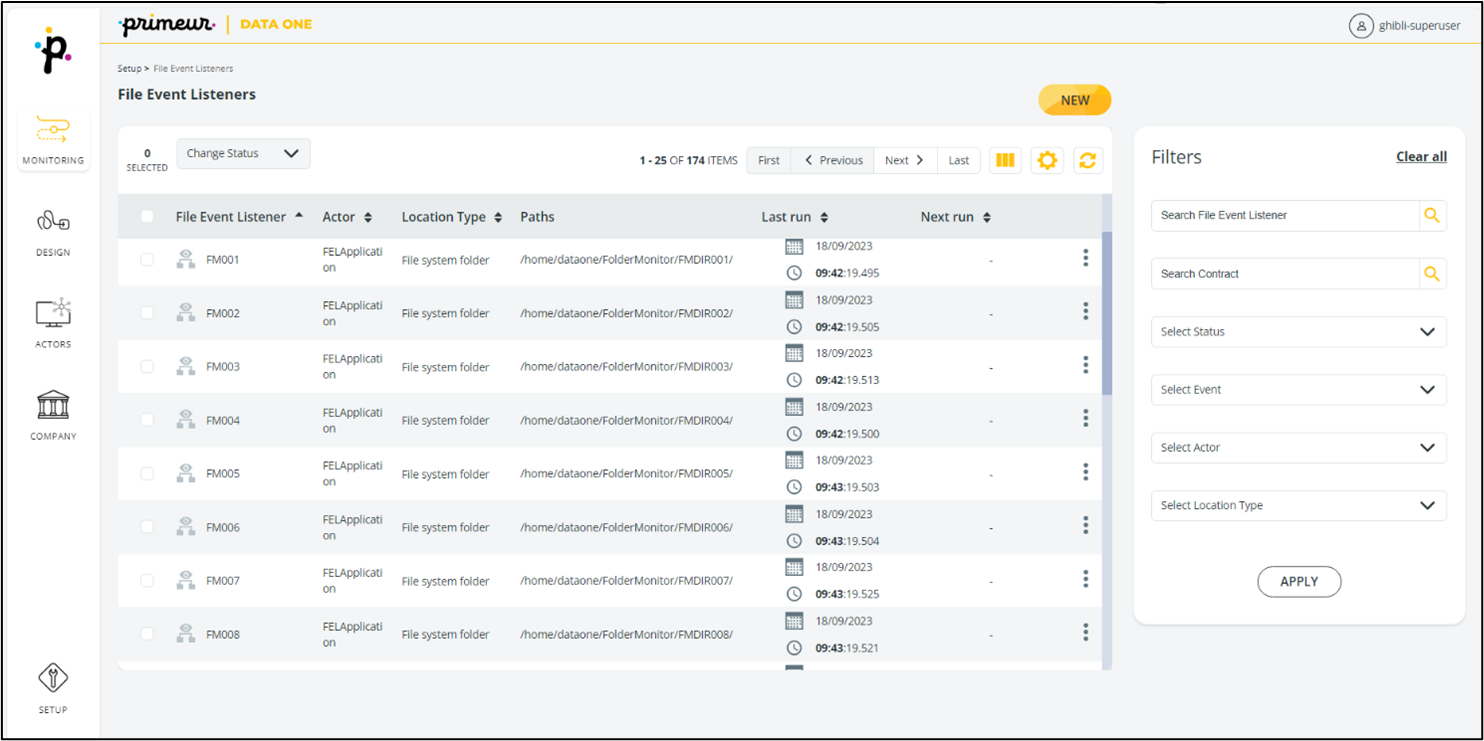Setting events to be monitored
Configuration of events to be monitored occurs in the Setup → File Event Listeners section of Data One.
When going to Setup → File Event Listeners, the following home page appears listing already configured File Event Listeners. If nothing is configured, the page will show that no results are available.

To create a new listener event, follow these steps:
- In Setup → File Event Listeners, click the NEW button.
- The New File Event Listener window will appear.
- In the New File Event Listener window, fill in the fields:
- Name (*): assign a name to the File Event Listener. A maximum of 128 characters are accepted.
- Description: (optional) enter a description for the File Event Listener you are configuring. A maximum of 255 characters are accepted.
- Status: (optional) select the status of the activity. Possible options are:
- On: the configuration is saved and file events are monitored.
- Off: the configuration is saved but file events are not monitored.
- Actor (*): select an actor to be associated with your File Event Listener..
After you have selected an Actor, the following fields will appear:
- Location type (*): select the location type for your File Event Listener. You can either select a local (file system folder) or a remote location (SFTP, SMB3).
- Monitoring details:
- Client Connection (*): (Only for remote location types: SFTP and SMB3) select the Client Connection associated with the protocol type previously chosen.
- Check every (*): specify the polling interval in minutes (default) or seconds. For minutes, values accepted go from 1 (minimum) to 1440 (maximum). For seconds, values accepted go from 30 (minimum) to 86400 (maximum). The default value is 10 minutes.
- Cluster (*): select the STENG cluster where the File Event Listener will run.
- Events to be monitored (*): specify the events to be monitored. Files created and modified can be monitored. Note that only contracts associated with the system-onDemand_FEL_v2 system workflow will be displayed in this section.
To enable an event, check the box and select the associated action to be fired in the list of all defined actions. - Paths to be monitored :
- Paths (*): define the paths that must be monitored. Enter one path name at a time and press the Add button to confirm. At least one path must be specified. Note that one File Event Listener can monitor only one path at a time. The path will appear below the Add button and can be removed by clicking the x.
- Recursive monitoring (*): define if folders and subfolders must be monitored recursively. Select:
- Disabled (default) if you do not want to apply recursive monitoring.
- Enabled if you want to apply recursive monitoring.
- Limited to define a specific number of nested levels.
- File Name: select which files to monitor/not to monitor in each path through Wildcards or a RegEx. You can specify a filename pattern using these Wildcards: * (asterisk), which can represent any number of characters (including zero) and ? (question mark), which can represent any single character. Each multiple selection must be separated by a , (comma). Here are some examples:
- *.log filters all files with the .log extension
- test*filters all files with a filename that starts with the word test
- test*.log filters all files with a filename that starts with the word test and that have the .log extension
- test?.log filters all files with a filename that starts with the word "test" followed by a single character and that have the .log extension
See the following page for more information about RegEx rules.
Click on the icon next to the File Name wording for a brief description of Wildcards and RegEx rules.
icon next to the File Name wording for a brief description of Wildcards and RegEx rules.
At least one path must be specified. Note that a path can be monitored by only one File Event Listener at a time.
The path will then appear below the Add button and can be removed by clicking the x.
 Warning!
Warning!Deleting a path to be monitored
When you remove a path from the list of paths to be monitored, all associated Wildcards and RegEx you have selected will be removed as well. If you decide to monitor the path/folder at a later date, you will need to insert Wildcards and RegEx again as the system does not retain their history.
- Ignore policies: (optional) specify if any of these files must be ignored:
- Error on paths (ignored by default, so incorrect or non-existing paths do not cause the File Event Listener to stop and viceversa).
- Pre-existing files on the first scan.
- Files with size smaller than a specific number of bytes.
- (Only for the file system folder location) Files created/modified in the last X seconds (default 60 seconds, range 1 to ∞ seconds) – UPDATE TIME.
- Files created/modified in the last X runs (default 1 run) – POLL INTERVAL. Note that a run corresponds with the number of polls, or checks, that must pass with the file not changing in size before it is considered stable and eligible for processing.
- Specific files patterns included in a blacklist. Files must be separated by commas, and can contain the “*” wildcard e.g. *.partial, *.part, temp*.
At the top of the list of results, multiple options are available.

Learn how to use the toolbar on the right of the page here.
Multiple activities can be Enabled or Disabled in one go simply checking the activity in the result list and then selecting Enable or Disable in the drop-down list. Checking the box on the left of SELECTED, all entries in the result list will be selected or deselected.
The status of the monitoring can be identified at a glance in the result list with these icons:
 the listening activity is enabled and running.
the listening activity is enabled and running.
 the listening activity is disabled and not running.
the listening activity is disabled and not running.
 an error in the listening activity has occurred. The reason of the error can be detected in the Central Log.
an error in the listening activity has occurred. The reason of the error can be detected in the Central Log.
 the File Event Listener engine is down. The reason of the error can be detected in the Central Log.
the File Event Listener engine is down. The reason of the error can be detected in the Central Log.
Each icon is completed with a tooltip.
Clicking the icon on the right of the row, the Edit and Delete options are available.
icon on the right of the row, the Edit and Delete options are available. If a File Event Listener instance is listening more than one directory, those are shown in the Paths column. The column shows up to two paths, additional paths can be seen in the tooltip that appears by hovering over the More paths defined wording.
In the Filters panel on the right, you can filter results by:
- Name of the File Event Listener
- Contract the File Event Listener is associated with
- Status (enabled or disabled)
- Event (file created or file modified)
- Actor the File Event Listener is associated with
- Location type
Updated 17 days ago
